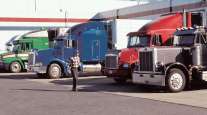Fleets Raising Driver Pay
This story appears in the July 26 print edition of Transport Topics.
The number of fleets that raised driver pay in the second quarter increased sharply, and continuing difficulties in attracting new drivers could spark another round of increases in the third quarter, several industry experts have said.
About 20% of truckload fleets increased pay in the second quarter, compared with 1.7% in the first three months of 2010, said Gordon Klemp, principal of the National Transportation Institute, Kansas City, Mo.
More than a third of flatbed carriers raised pay in the second quarter, followed by 20% of refrigerated fleets and 11% of dry van operators, Klemp said. That trend was a sharp turnaround from June 2009, when at least one-third of fleets cut pay to stay afloat during the recession.
“Before the end of the third quarter, at least one major carrier will make a bold move to attract drivers with pay and kick off a significant round of pay increases,” Klemp predicted, without identifying the fleet or fleets.
More increases are expected because the number of fleet requests for special pay studies rose 50% in the first half of this year, Klemp said. Based on past experience, at least 70% of the carriers that ask for those studies decide to raise wages.
Klemp, who publishes his report based on a survey of nearly 400 fleets, said pay rose an average of 4.5 cents a mile in the flatbed sector, more than twice the increase at dry van and refrigerated fleets.
Maverick Transportation LLC, Little Rock, Ark., raised pay for experienced flatbed drivers a total of 6 cents a mile in 30 days during the second quarter. The second increase of 2 cents a mile on June 6 brought pay to 42 cents a mile and followed an increase of 4 cents a mile earlier in the period.
Crete Carrier Corp. and its Shaffer Trucking and Hunt Transportation units on July 1 restored 3 cents a mile in pay for new drivers, reversing a cut made more than two years ago as demand slumped. Crete, based in Lincoln, Neb., didn’t cut pay for current drivers.
As with Crete, many of the increases at other fleets brought pay levels back to where they were before the recession slashed profits.
Several experts said the pace of future pay increases is intertwined with fleet profitability, which rose in the second quarter, at least among public companies, and driver availability.
“Wages are not going up yet for the most part, but companies are feeling pressure in terms of finding drivers, and they may have to respond with raises,” said Satish Jindel, who heads SJ Consulting Group Inc., Sewickley, Pa.
Jindel, who also said some fleets have increased hiring, said that carriers should not be bashful about limiting hiring and pay increases until after their profit margins are restored to pre-recession levels.
Jeff Davis, a vice president at Jet Express, Dayton, Ohio, agreed.
“Company profits are going to have to go up before there are more driver pay increases,” Davis said. “There are so many motor carriers who are just holding their own and living from month to month.”
Davis linked driver pay trends to the federal Compliance, Safety and Accountability program, formerly called CSA 2010.
The potential for CSA to disqualify some drivers could be “the straw that breaks the camel’s back when it comes to pay increases,” Davis said.
That could happen, he said, because fleets may need to pay more to keep qualified drivers as others are forced out of the industry by violations that previously didn’t count against them.
Davis, who hosted a Truckload Carriers Association webinar about driver hiring on July 7, urged fleets to use newly available federal driver performance data both to identify the best drivers and to improve deficient performance now.
Moving promptly to address driver issues is especially important, he said, because violations occurring now are counted with triple the weight of earlier infractions.
Davis said that he believes driver hiring and pay will change gradually.
Klemp, meanwhile, also pointed out that signing bonuses now are offered by 22% of trucking fleets and have reached $3,000 for solo drivers and six in seven fleets are offering referral bonuses that range as high as $1,500.




